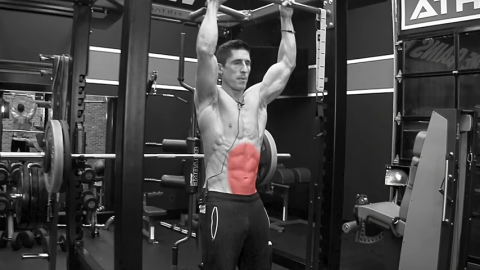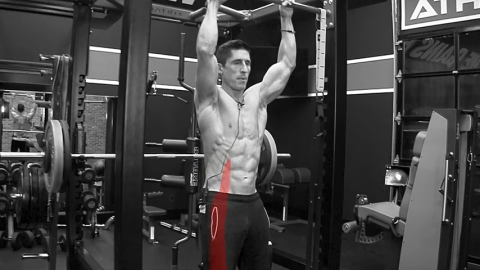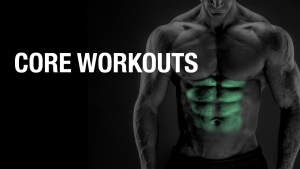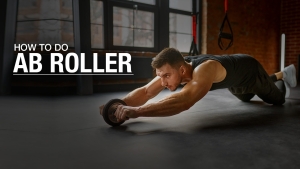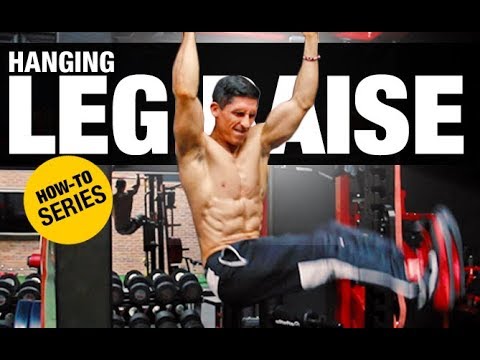
HOW TO DO HANGING LEG RAISES
How many times have you seen guys swinging on a Pull-Up bar, kind of lifting their legs up, and you wonder, “What exercise are they doing?” Maybe you ARE this guy.
The Hanging Leg Raise is one of the best ways to target not just your abdominal muscles, but also your obliques and hip flexors, depending on the angle you use.
You can look through plenty of comprehensive exercise libraries for abs, and I guarantee that you’ll find this to be an awesome exercise across the board. It might be one of the best, but it’s also one of the exercises that is performed incorrectly the most.
In this article, I’m going to break down exactly how to do Hanging Leg Raises so you can confidently execute them with proper form in your exercise routine.
Best of all, I’ll explain how to do leg raises whether you’re just starting out or you’ve been lifting for years.
Even if you think you are doing these advanced bodyweight exercises perfectly, it can’t hurt to do a refresher course. After all, you might be surprised to find out that you’re missing a critical form cue.
If you have shoulder issues and you think Hanging Leg Raises are never going to happen, I’ve got you covered! I’m going to also show you some modifications to the exercise to make sure anybody with shoulder issues can do it.
MUSCLES TARGETED IN THE HANGING LEG RAISE
Before we get started on learning how to do Hanging Leg Raises, I want to cover the muscles that can be targeted during this advanced exercise.
Depending on how you perform Hanging Leg Raises and the angle of your feet and body, you could effectively target one of the three major muscle groups:
ABDOMINALS
Everybody talks about this being one of the best abdominal exercises and it is! The reason is because the weight of the legs is being used as your resistance, which makes it more difficult but also more rewarding.
The abdominal muscles are the most obvious target during Hanging Leg Raises. The rectus abdominis is essential to the entire core, acting like a support column for the front of your body and spine.
A lot of people confuse abs (rectus abdominis muscles) for the core muscles, thinking they are one in the same. The truth is that the abdominal muscles are just ONE part of the core muscles.
With your body in a straight line, you can focus on bringing your legs up – curling your abs – to target these muscles.
OBLIQUES
It’s important to note that the obliques are also involved in the Hanging Leg Raise. The obliques are those triangular muscles on either side of your abs, and they help with twisting movements. Just like the abs, they are one important part of the entire core.
As I’ll cover below, you can target your obliques by adding in rotation of the legs and knees during the Hanging Leg Raise.
HIP FLEXORS
Finally, you can also target the hip flexors with Hanging Leg Raises. The hip flexor muscles run from your core to your thigh muscles and they are responsible for helping to bring your legs up towards the torso.
You might wonder why you would want to focus on the hip flexors during a movement that is seemingly made to target the abs and obliques only. It has everything to do with your quads.
A lot of quad muscle strain comes from having weak hip flexors, and this is why you would want to incorporate hip flexor mobility exercises into your fitness program.
Something like an extended Glute Bridge can go take a normal hip flexor exercise and change it into a challenging, core-shaking, mobility movement. It just depends on how much intensity you show up with.
HOW TO DO THE HANGING LEG RAISE
Now that we have a good understanding of which muscles are targeted during Hanging Leg Raises, let’s learn how to do them correctly!
Before we begin, find a pull-up bar or chin-up bar, and place an exercise mat underneath of it for safety and support. If you need a weight bench to step up on to reach the grip bar, that’s okay!
I’m going to breakdown exactly how to do this high-level isolation exercise to target each of the three muscle groups I mentioned above. We start with the abdominals.
HANGING LEG RAISES FOR ABS

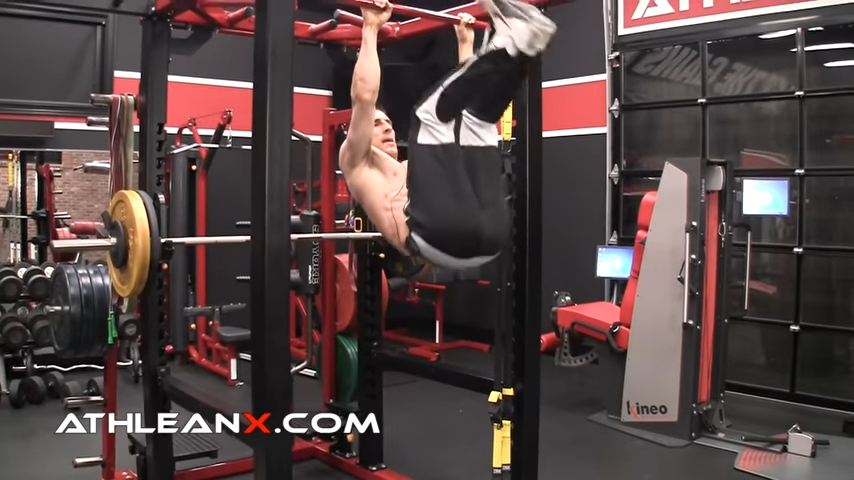
HOW TO DO HANGING LEG RAISES FOR ABS:
- The starting position is to jump up on the bar and dead hang with a slight bend in the elbow.
- Put your hands shoulder width apart – do not use an underhand grip as this will promote swinging. Make sure you have a strong overhand grip on the chin-up bar.
- Focus on bending at the pelvis and curling it upward with spinal flexion so that you are showing everyone your butt.
- This is more than just leg lifts. You want to flex the spine and bring your legs up but not too high. You don’t want to turn this into a toes-to-bar exercise. Instead, pull in your belly button and curl your pelvis up so that your legs are still being pulled down by gravity, focusing the core muscles to do the job.
- You can eventually work up to using ankle weights, but I’d rather see you perfect using bodyweight during these pelvic crunches.
WHAT MAKES IT EFFECTIVE: By focusing on curling the pelvis – not just lifting your legs up – you properly activate the target muscles.
HANGING LEG RAISE FOR OBLIQUES


HOW TO DO HANGING LEG RAISES FOR OBLIQUES:
- From the same starting position as before on the bar, make sure you have a shoulder width overhand grip. It might be tempting to use a wide grip here, but try to keep it at or just outside of shoulder width.
- Above all, it’s important to bend from the obliques – the rib cage. Do NOT bend from the hips or waist, otherwise you won’t target the oblique muscles. Again, make sure you have a strong grip before you begin.
- Spread the legs a part just a bit, and then flex from the rib cage, adding a slight twist to the left side.
- Control your descent during the entire exercise and repeat on the other side.
WHAT MAKES IT EFFECTIVE: This tough exercise is actually one of the best oblique exercises you could possibly do, but it matters where are you bending from.
HANGING LEG RAISE FOR HIP FLEXORS


HOW TO DO HANGING LEG RAISES FOR HIP FLEXORS:
- The goal here is to focus on bending the legs past 90 degrees. That means you have to focus on where you’re bending.
- Focus on bending and lifting straight through the hip socket up and above 90 degrees, but do not allow the legs to come all the way back down to the ground.
- Stop them from descending when they are parallel to the ground and immediately go back up for the next rep.
- Keep the upper body and spine neutral.
WHAT MAKES IT EFFECTIVE: By limiting the range of movement where the legs are parallel with the ground and up past 90 degrees, you’re putting all the work on the hip flexor muscles.
ARE YOU SWINGING DURING YOUR HANGING LEG RAISES?
Guys, you might have read through everything above and said to yourself, “Yeah, that’s how I think I do them already but I’m not feeling it in that muscle.”
Well, I have a question for you: Do you swing your body in the hang position when you do the Hanging Leg Raise exercise?
If you do, this could be the reason why you don’t find this calisthenics exercise to be very effective.
I’m going to show you a really simple way to make sure that you’re not swinging and you maintain a position of control when you’re doing a Hanging Leg Raise. You can use this same technique while doing a pullup.
You’ll need to head over to the Captain’s Chair to do this list of progressions. The Captain’s Chair allows you build core strength and master each progression before moving to the next. This exercise trains grip strength if you’re weak and you’re not quite ready to hang from the chin-up bar.
The end goal, of course, is you back on the pull-up bar doing perfect Hanging Leg Raises.
PROGRESSION ONE
Sit back into the Captain’s Chair and rest your forearms down. You’ll also place your back into the pad, and this provides you with an additional point of contact. This gives you a lot of stability between your back and the pad.
Once you are stabilized well, you’ll start with Hanging Knee Raises or a simple Chair Leg Raise targeting the abs.

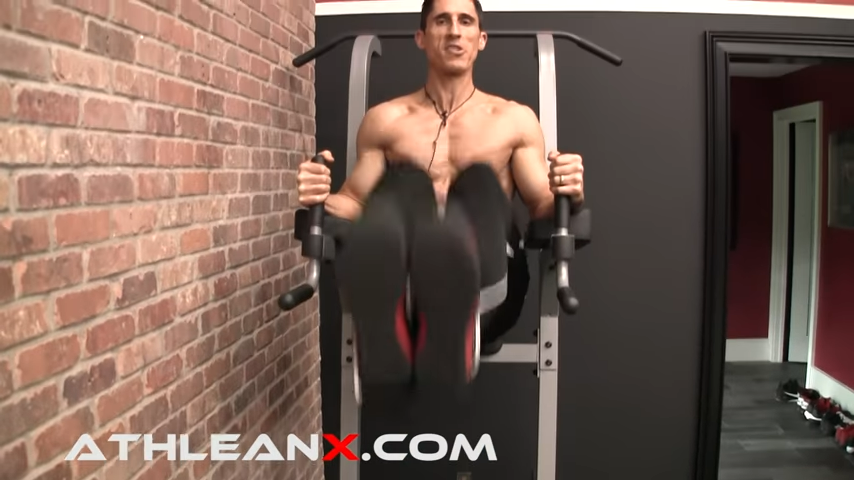
Keep your back pressed into the back of the Captain’s Chair as you focus on curling the pelvis up, bringing your knees up, and showing your butt. You can think of it like you’re doing a Reverse Crunch.
You might have been doing these already, bringing your knees up to a parallel 90-degree angle, but I’m telling you to go higher than this!
It might sound weird, but you’ve got to make sure that whoever is in front of you can see the bottom of your pelvis because this signifies that you’re flexing and curling from the bottom, up.
PROGRESSION TWO
After you’ve mastered that, you move away from the back pad to the dip station, which is going to challenge your stability.
On the plus side, the dip station allows you to use your lower traps to depress your shoulder blades and provide that needed stability.

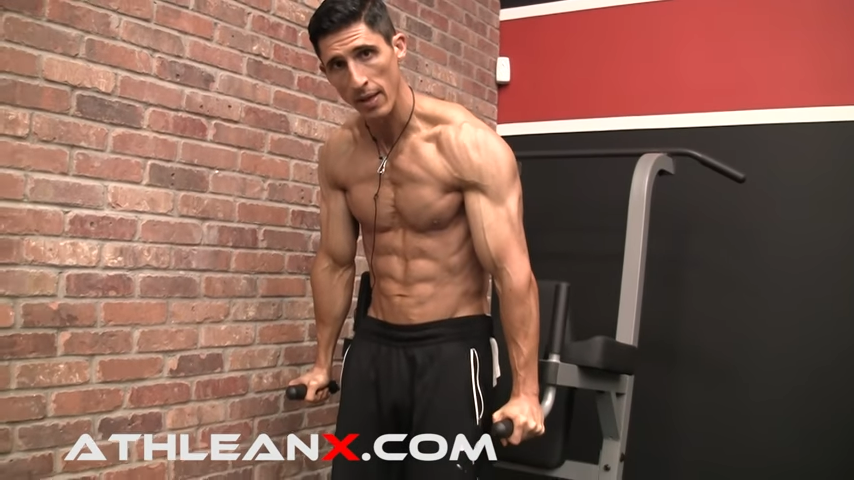
The way to do this is to push down and focus on pushing the shoulder blades down and creating stability.
At the same time, point your toes a little bit to engage your abs.
You only need to point the feet a little bit in front of your body because if you go too far backward, this will promote swinging.
Once you get in this position, you can do your leg raises. It might help to think of them as a Hanging Leg-Hip Raise.
Again, you should use the same cues as above. Curl the pelvis up and show the bottom.
You know you’re doing this correctly if you’re able to stop at any point in time and not worry about swinging.
Now, how do we transition this to the more difficult, and more popular version, which is hanging from a pull-up bar?
PROGRESSION THREE
From the bar, you know that your focus needs to be on stabilization, and this is a quick and easy fix. There are two parts to it:
Before the leg raise starts, the first thing you want to do is create stability from the bottom, up.

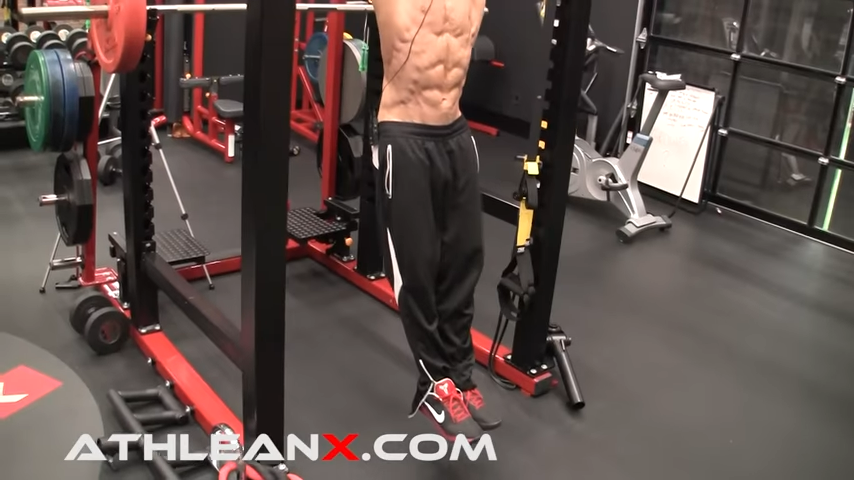
You can do that by moving your legs just a little bit in front of your body.
By moving the feet and legs a little bit in front of your body, you create contract the abs and provide stabilization in the front.
The next thing you need to do is provide stabilization from the back, and that’s where step two comes in.

Chances are, if you were able to look at your back from the hanging position, you would see that the shoulder blades are not really supported – They’re just hanging here.
The goal here is to engage those lower traps by depressing them. In other words, focus on pulling them down while keeping the legs slightly in front of your body.
Again, keep your arms straight, and then do a scapular depression.
From here, follow the same cue I’ve repeated throughout this article: start the leg-hip raise by curling the pelvis up so that you are showing your butt to whomever is in front of you.
GO SLOW AND FOCUS ON THE CONTRACTION
The other mistake that people make when doing hanging leg raises is that they go too fast.
They think that if they go really fast then they’ve created stability because they “look” like they aren’t swinging.
In reality, all they’ve done is use momentum to move themselves up and down. They aren’t contracting the muscle; they are just using momentum.
This is doing nothing for core strength.
What you want to do instead is go slow and focus on the contraction of the muscles.


So, if we put it all together: you’ll depress the shoulders, move your legs out in front, focus on controlling the curl of the pelvis, show your butt, and SLOWLY bring your legs back down.
You should lock it in place at the bottom of every rep, and you should not be swinging at all.
Once you feel confident that you’re doing it properly, it’s probably not a bad idea to ask a personal trainer in your gym to watch your form and give you some tips. If you don’t have access to a personal trainer, simply record yourself and play it back in comparison to how I’m doing them.
MODIFICATIONS FOR THE HANGING LEG RAISE
Let’s say you’ve got plenty of core strength, but the one thing that is holding you back is your shoulders. Then what?
The solution is simple: use the Captain’s Chair.


If you’re not able to hold on and support your body weight on the pull-up bar, you could do the same three fantastic core exercises in the Captain’s Chair.
As I demonstrated above, you’re still able to flex and curl the target muscles, no matter which one you’re working on.
When it comes to perfecting your form on the hanging leg raise, sometimes it’s those little, tiny tricks that work so well, and help you finally do this challenging exercise once and for all.
If you’re not quite at that fitness level, that’s okay. You can easily match up where you are in your ability to do hanging leg raises with the modification I recommend above.
I promise you that it’s going to work no matter what part of progression you start at, and if you keep at it, you’ll see six-pack muscle in no time.
If you’re looking for a complete training program to build muscle from head to toe, check out our ATHLEAN-X programs to see which one best fits your goals and fitness level.

- By adjusting your feet and body angle during Hanging Leg Raises, you will be able to accurately target any one of the three major muscle groups: abs, obliques, or hip flexors with different challenging variations.
- No matter which muscle group is your goal, you want to emphasize pelvic flexing and curling upwards as though you are showing the world your derriere.
- If you’re having trouble performing a Hanging Leg Raise, follow this progression of modifications:
- Step One: In a Captain’s Chair, concentrate on curling your pelvis up, moving your knees up toward your chest while pushing your back firmly into the padding.
- Step Two: After you’ve mastered that, go to the dip station, and focus on pushing the shoulder blades down while pointing your toes out a little bit to engage your abs.
- Step Three: On the pull-up bar, do everything you learned above: depress the shoulders, move your legs out in front, and focus on controlling the curl of the pelvis from the bottom, up.
- Above all, be sure to take your time and focus on the contraction of the muscle. Do NOT use momentum.
- Finally, if you have shoulder issues, follow these same form cues but do so on the Captain’s Chair.
HANGING LEG RAISES FAQS
Hanging leg raises are important to include in your advanced core workout routine because you can adapt this intense exercise to build muscle strength in the entire rectus abdominis, obliques or hip flexors. There are different leg raise variations that will help you target your desired muscles. Leg raises are a great exercise to include in your core workout if you're looking to get six-pack abs.
Core exercises like hanging leg raises or even traditional crunches will help you build a strong core but, they are not belly fat-burning exercises. The hanging leg raise is a fantastic strength-training exercise for building the ab muscles, but in order to burn belly fat, you'll have to focus on adapting your nutrition plan to help burn fat throughout the entire body to get the abdominal muscles to show.
REFERENCES

Jeff Cavaliere M.S.P.T, CSCS
Jeff Cavaliere is a Physical Therapist, Strength Coach and creator of the ATHLEAN-X Training Programs and ATHLEAN-Rx Supplements. He has a Masters in Physical Therapy (MSPT) and has worked as Head Physical Therapist for the New York Mets, as well as training many elite professional athletes in Major League Baseball, NFL, MMA and professional wrestling. His programs produce “next level” achievements in muscle size, strength and performance for professional athletes and anyone looking to build a muscular athletic physique.
















